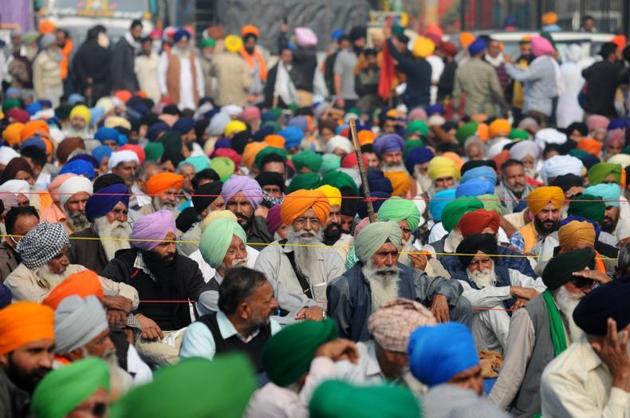Farm to factory: Small farmers need second source of income
Farming is a seasonal affair, not a full-time job. The second job option is mostly required by the small, marginal farmers and farm labourers in nearby areas. Industrial investment should be encouraged in rural and backward areas by offering special incentives.
In farming, size matters. 70% of India’s farmers have small and marginal land holdings, operating below one hectare. On an average, smaller holdings lose money as their household costs are higher than their earnings.

According to the National Sample Survey Office (NSSO), the average income of farmers owning up to two hectares is ₹5,240 a month. The smallest farms are afloat since they don’t pay for labour, relying entirely on the family, and they consume much of what is produced.
A proposed amendment in the three central farm laws may lead to reforms in the agriculture sector but with small farming, a second employment option is a must for marginal farmers and farm labourers.
Farming is a seasonal affair, not a full-time job so the second job option is mostly required by small, marginal farmers and farm labourers in nearby areas. Industrial investment should be encouraged in rural and backward areas by offering special incentives.
Farm to factory is the need of the hour. Apart from part-time seasonal farming, a small farmer and a farm labourer have sufficient time to work and can earn ₹12,000- ₹15,000 a month easily after eight hours of labour in a nearby factory. This can ensure an additional income to minimise the dependency on the sole agriculture-based income.
Of the 8,000 workers at the Sonalika plant in Hoshiarpur, 90% are marginal farmers and farm labourers of nearby villages. This model of linking industry with employment for marginal farmers and farm labourers can be amplified pan-India, particularly in the backward areas. It would be the real execution of sab ka saath, sab ka vikas (progress for all), covering more than 60% of the population of the country residing in rural and backward areas.
DISAFFECTED YOUNGSTERS PREFER TO MOVE OUT
Fundamentally, India must figure out a way to provide meaningful employment to people outside agriculture. Failing to do so means not just a failure of human development but also underemployment and disaffected youngsters, particularly children of farmers, who want to emigrate to Canada or other places because there are no jobs. Small farming is not so lucrative and the younger generation does not want to follow in their parent’s footsteps, which pushes them to work in cities. Unfortunately, urban areas, while offering more opportunities, also relegate many to low earning jobs. While working in cities, the earning and expenses of rural youngsters are at par, their net income is negligible to help out their families in villages. So, it is not lucrative for them to work in cities far from their native villages.
A realistic hope is the promotion of new industrial investment with a special incentive in backward areas to provide new jobs to rural India.
Though economic liberalisation in 1991, has paved the path of globalisation and foreign direct investment (FDI) in India but before this liberalisation, the central government preferred to issue conditional licences and incentives to promote the industry in rural and backward areas only. Delicensing of the industry also lost the crucial aspect of locating industry in rural or distressed backward area growth.
In 30 years, industrial growth has shifted from rural or backward areas to crowded industrial areas in cities. As earlier, licensing and incentives were higher for industrial investments in rural and backward areas. In the 1970s, JCT, Hawkins cookware and Mahavir spinning mills had invested in Hoshiarpur, the most backward area of Punjab, because of licensing terms and special incentives offered by the central government.
INCENTIVISE INDUSTRIAL INVESTMENT IN VILLAGES
As a relief under the Covid-19 pandemic, the Centre has introduced production-linked incentive (PLI) schemes of ₹1.96 lakh crore, but they will not attract industrial investment in rural and backward areas. Before this, the government codified 29 central labour laws into four codes but none of these policies are sufficient to attract industrial investment in rural and backward areas. Prime Minister Narendra Modi’s Atmanirbhar philosophy of development has to be applied to provide special incentive to industrial investment in rural and backward areas. To increase export from these areas, 50% relaxation in railway freight as freight subsidy can be provided from dry ports such as Delhi and Ludhiana. As of now, most industrial investments are being attracted by southern states near seaports but for Make in India and self-reliance, employment generation in rural and backward areas needs to be incentivised.
Special incentives are being offered to develop industrial corridors and clusters but this model should be replicated in the rural and backward areas to provide job opportunities to nearby small and marginal farmers and farm labourers. The traditional models of job generation have to be re-evaluated. A distributed, micro-level factory that can produce solopreneurs and micro-enterprises has to be created and supported in the rural areas. For instance, processing and packaging of vegetables for sale in urban malls can be a micro-enterprise that may not need high capital investment but will be labour-intensive at the block level in the backward areas.

Providing jobs to small, marginal farmers and farm labourers in nearby areas will minimise the rural-to-urban migration. On ground reforms in the agriculture sector through central amended laws will take more time but it is time for a policy and framework to promote industrial investment in rural and backward areas as a job engine for small, marginal farmers and farm labourers.



